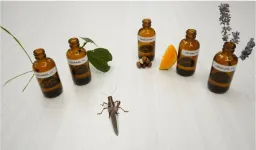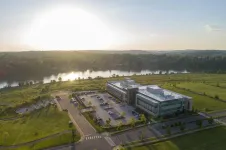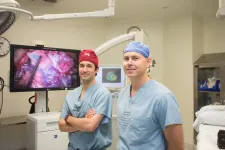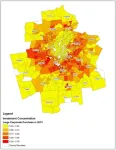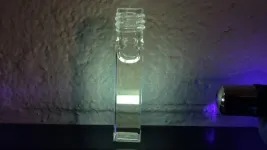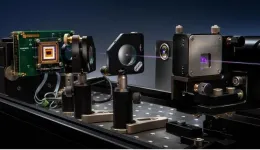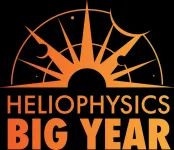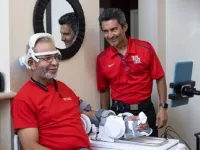(Press-News.org) Everyone has scents that naturally appeal to them, such as vanilla or coffee, and scents that don’t appeal. What makes some smells appealing and others not?
Barani Raman, a professor of biomedical engineering at the McKelvey School of Engineering at Washington University in St. Louis, and Rishabh Chandak, who earned bachelor’s, master’s and doctoral degrees in biomedical engineering in 2016, 2021 and 2022, respectively, studied the behavior of the locusts and how the neurons in their brains responded to appealing and unappealing odors to learn more about how the brain encodes for preferences and how it learns.
The study provides insights into how our ability to learn is constrained by what an organism finds appealing or unappealing, as well as the timing of the reward. Results of their research were published in Nature Communications Aug. 5.
Raman has used locusts for years to study the basic principles of the enigmatic sense of smell. While it is more of an aesthetic sense in humans, for insects, including locusts, the olfactory system is used to find food and mates and to sense predators. Neurons in their antennae convert chemical cues to electrical signals and relay them to the brain. This information is then processed by several neural circuits that convert these sensory signals to behavior.
Raman and Chandak set about to understand how neural signals are patterned to produce food-related behavior. Like dogs and humans salivating, locusts use sensory appendages close to their mouths called palps to grab food. The grabbing action is automatically triggered when some odorants are encountered. They termed odorants that triggered this innate behavior as appetitive. Those that did not produce this behavior were categorized as unappetitive.
Raman and Chandak, who earned the outstanding dissertation award from biomedical engineering, used 22 different odors to understand which odorants the locusts found appetitive and which they did not. Their favorite scents were those that smelled like grass (hexanol) and banana (isoamyl acetate), and their least favorites smelled like almond (benzaldehyde) and citrus (citral).
“We found that the locusts responded to some odors and not others, then we laid them out in a single behavioral dimension,” Raman said.
To understand what made some odorants more likable and others not, they exposed the hungry locusts to each of the scents for four seconds and measured their neural response. They found that the panel of odorants produced neural responses that nicely segregated depending on the behavior they generated. Both the neural responses during odor presentation and after its termination contained information regarding the behavioral prediction.
“There seemed to be a simple approach that we could use to predict what the behavior was going to be,” Raman said.
Interestingly, some of the locusts showed no response to any of the odors presented, so Raman and Chandak wanted to see if they could train them to respond. Very similar to how Pavlov trained his dog with a bell followed by a food reward, they presented each locust with an odorant and then gave them a snack of a piece of grass at different time points following the odor presentation. They found that locusts only associated appealing scents with a food reward. Delaying the reward, they found that locusts could be trained to delay their behavioral response.
“With the ON-training approach, we found that the locusts opened their palps immediately after the onset of the odor, stayed open during the presentation of the odor, then closed after the odor was stopped,” Raman said. “In contrast, the OFF-training approach resulted in the locusts opening their palps much slower, reaching the peak response after the odor was stopped.”
The researchers found that the timing of giving the reward during training was important. When they gave the reward four seconds after the odor ended, the locusts did not learn that the odor indicated they would get a reward. Even for the appealing scents no training was observed.
They found that training with unpleasant stimuli led locusts to respond more to the pleasant ones. To explain this paradoxical observation, Raman and Chandak developed a computational model based on the idea that there is a segregation of information relevant to behavior very early in the sensory input to the brain. This simple idea was sufficient to explain how innate and learned preference for odorants could be generated in the locust olfactory system.
“This all goes back to a philosophical question: How do we know what is positive and what is negative sensory experience?” Raman said. “All information received by our sensory apparatus, and their relevance to us, has to be represented by electrical activity in the brain. It appears that sorting information in this fashion happens as soon as the sensory signals enter the brain.”
Chandak R, Raman B. Neural manifolds for odor-driven innate and acquired appetitive preferences. Nature Communications, Aug. 5, 2023., DOI: 10.1038/s41467-023-40443-2.
This research was supported by the National Science Foundation (1453022, 1724218, 2021795) and the Office of Naval Research (N00014-19-1-2049, 955 N00014-21-1-2343).
Originally published by the McKelvey School of Engineering website.
END
Good smells, bad smells: It’s all in the insect brain
Raman looks at natural and acquired preferences using locusts
2023-08-08
ELSE PRESS RELEASES FROM THIS DATE:
ORNL, UT’s Spark Cleantech Accelerator partner to support entrepreneurs
2023-08-08
Entrepreneur-fellows in Innovation Crossroads, a Department of Energy Lab-Embedded Entrepreneurship Program at Oak Ridge National Laboratory, will complete the Spark Cleantech Accelerator, a 12-week program offered by the University of Tennessee, Knoxville, Spark Innovation Center at the UT Research Park.
“By combining the resources of Innovation Crossroads and the Spark Cleantech Accelerator, we are building a stronger program for entrepreneurs,” said Dan Miller, program lead for Innovation Crossroads. “Entrepreneurial ecosystems depend on relationships among early-stage companies. This new collaboration — ...
Alfred E. Mann Charities, Inc. awards $500,000 to USC Neuro Revascularization Center
2023-08-08
The USC Neuro Revascularization Center (USC NRV Center) performs approximately 40-50 complex revascularization procedures per year, making it one of the most clinically robust programs in the country. Its multidisciplinary approach—combining plastic surgery, vascular surgery, and neurosurgery—is what allows the center to treat the most complex clinical cases and answer some of the toughest research questions.
A recent $500,000 gift from Alfred E. Mann Charities will support clinical excellence, novel research, and educational opportunities at the center with a clear focus ...
Opioids, methadone and babies
2023-08-08
LOS ANGELES (August 8, 2023) — Whatever the opioid crisis calls to mind, it likely isn’t pacifiers and diapers. But when 1 out of every 5 hospitalized infants receives opioids, and when some infants require methadone treatment, it’s time to widen the scope. A new study led by pediatric surgeons at Children’s Hospital Los Angeles shows that methadone use after surgery can prolong a baby’s recovery and increase an infant’s dependence on ventilators and intravenous (IV) nutrition.
To call the opioid problem in the United States a crisis is not hyperbole. The rate of death due to opioid overdose has risen ...
Investors force Black families out of home ownership, new research shows
2023-08-08
Investors have been buying houses at a steady rate since the last recession, but how much does it affect availability in the housing market? New research from the Georgia Institute of Technology shows investors are most likely to push out Black, middle-class homeowners from neighborhoods.
Data from 800 neighborhoods in the Atlanta metropolitan area between 2007 and 2016 revealed that major investors bought homes in majority-minority neighborhoods far from downtowns and in lower-income areas. These homes were often undervalued because of their minority populations, but they remained desirable and offered good market value.
The neighborhoods ...
Cybersecurity project plans to connect researchers across the country
2023-08-08
From building fighter jets to automobiles, the manufacturing world is increasingly adapting digital instruction as technology advances. Mechanical parts can be designed on a computer and shipped over the network to a manufacturing machine that follows digital instructions to produce a specific part. The move into the digital world makes securing online information a national interest.
Dr. Narasimha Reddy, a professor in the Department of Electrical and Computer Engineering at Texas A&M University, recently received a National Science Foundation grant to research cybersecurity ...
The “unknome”: a database of human genes we know almost nothing about
2023-08-08
Researchers from the United Kingdom hope that a new, publicly available database they have created will shrink, not grow, over time. That’s because it is a compendium of the thousands of understudied proteins encoded by genes in the human genome, whose existence is known but whose functions are mostly not. The database, dubbed the “unknome”, is the work of Matthew Freeman of the Dunn School of Pathology, University of Oxford, England, and Sean Munro of MRC Laboratory of Molecular Biology in Cambridge, England, and ...
Texas A&M's McKay receives NSF CAREER Award
2023-08-08
Dissolved organic matter (DOM) can be found in every water body on Earth, encompassing both saltwater and freshwater. It is a significant carbon source and is critical in environmental carbon cycling, which is the circulation of carbon in various forms through the environment and nature that makes the Earth sustainable for life.
The interaction between DOM and sunlight is essential for the carbon cycle to function effectively. However, the chemical structure of light-absorbing compounds, also known as chromophores, in DOM remains limited.
Dr. Garrett McKay, principal investigator of the Aquatic Chemistry Lab and assistant professor ...
Researchers use SPAD detector to achieve 3D quantum ghost imaging
2023-08-08
WASHINGTON — Researchers have reported the first 3D measurements acquired with quantum ghost imaging. The new technique enables 3D imaging on a single photon level, yielding the lowest photon dose possible for any measurement.
“3D imaging with single photons could be used for various biomedical applications, such as eye care diagnostics,” said researcher Carsten Pitsch from the Fraunhofer Institute of Optronics, System Technologies and Image Exploitation and Karlsruhe Institute of Technology, both in Germany. “It can be applied to image materials and tissues that are sensitive to light or drugs that become toxic when exposed ...
NASA announces monthly themes to celebrate the Heliophysics Big Year
2023-08-08
This October, NASA is launching the Heliophysics Big Year – a global celebration of solar science and the Sun’s influence on Earth and the entire solar system. Modeled after the “Big Year” concept from citizen scientists in the bird-watching community, the Heliophysics Big Year challenges everyone to get involved with fun Sun-related activities.
For each month from October 2023 to December 2024, the Heliophysics Big Year will celebrate under a theme, sharing opportunities to participate in many solar science events from watching eclipses to joining citizen science projects. During ...
Stroke rehab at home is near
2023-08-08
The world of at-home stroke rehabilitation is growing near, incredible news for the 795,000 people in the United States who annually suffer a stroke. A new low cost, portable brain-computer interface that connects the brain of stroke patients to powered exoskeletons for rehabilitation purposes has been validated and tested at the University of Houston.
“We designed and validated a wireless, easy-to-use, mobile, dry-electrode headset for scalp electroencephalography (EEG) recordings for closed-loop brain–computer ...
LAST 30 PRESS RELEASES:
School meals could unlock major gains for human and planetary health
Menopause hormone therapy does not appear to impact dementia risk
Signature patterns of brain activity may help predict recovery from traumatic brain injury
Dresden study uncovers new key mechanism in cancer cells
New species are now being discovered faster than ever before, study suggests
Cannabis-based products show limited short-term benefit for chronic pain, with increased risk of adverse effects
Cannabis products with more THC slightly reduce pain but cause more side effects
Clearing the brain of aging cells could aid epilepsy and reduce seizures
Brain injuries linked with potential risk of suicide, new study finds
New technique lights up where drugs go in the body, cell by cell
New study finds movement of fishing fleets can reveal shifts in marine ecosystems
Embargoed: New evidence points to potential treatment for vascular dementia
Study uncovers disrupted brain balance in alcohol dependence
Working in groups can help Republicans and Democrats agree on controversial content moderation online
Structural findings reveal how distinct GPCR ligands create different levels of activation
Anything-goes “anyons” may be at the root of surprising quantum experiments
UC review: Maximizing workplace opportunity for veterans
From generation to complex control: Metasurfaces make perfect vortex beams "within reach"
Thin-film lithium niobate-based detector: recent advances and perspectives
Exploring why some people may tend to persistently make bad choices
How cells balance their protein levels
Nirsevimab vs RSVpreF vaccine for RSV–related hospitalization in newborns
Effectiveness and impact of maternal RSV immunization and nirsevimab on medically attended RSV in US children
AI gives scientists a boost, but at the cost of too many mediocre papers
Next-generation vision model maps tree growth at sub-meter precision
Genes aren’t destiny for inherited blindness, study shows
MIT study: High-fat diets make liver cells more likely to become cancerous
Exposure to multiple fine particulate matter components and incident depression in the US Medicare population
Risk of burdensome health care spending over time in the US
Nirsevimab against hospitalizations and emergency department visits for lower respiratory tract infection in infants
[Press-News.org] Good smells, bad smells: It’s all in the insect brainRaman looks at natural and acquired preferences using locusts
